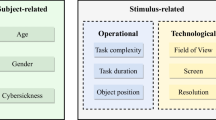Abstract
The illumination environment is extremely important to the visual-related operation/interface design, due to its great effect on visual operation. Therefore, the influence of illumination environment factors, such as illumination and color temperature, on visual operation needs to be investigated deeply. In this study, five illumination environment levels, combined by illumination and color temperature, were selected to carry out ergonomic experiments. The screen brightness of high, medium and low was set, and the internal experiment of two-factor subjects was conducted based on the visual search task. Behavioral performance data and subjective evaluation data of 16 subjects were collected and analyzed. The results show that, in terms of response time, correct rate, and subjective evaluation, the main effects of illumination and screen brightness are significant.
Access this chapter
Tax calculation will be finalised at checkout
Purchases are for personal use only
Similar content being viewed by others
References
Yang, G.: Visual and Visual Environment (Revised Edition). Tongji University Press, Shanghai (2002)
Shimomura, Y., Iwanaga, K., Harada, H., et al.: Effects of the color temperature of illuminance on arousal level in working. J. Physiol. Anthropol. 20(2), 149 (2001)
Tanabe, S., Nishihara, N.: Productivity and fatigue. Indoor Air 14(7), 126–133 (2004)
Manav, B.: An experimental study on the appraisal of the visual environment at offices in relation to color temperature and illuminance. Build. Environ. 42, 979–983 (2007)
Cai, J., Yang, F., Du, P., Cai, B.: The influence of different brightness and large size display on visual health and comfort—taking the comparison of LED and DLP display as an example. China Illum. Eng. J. 01, 94–98 (2015)
Li, S.: Research on indoor environmental quality evaluation model of office buildings. Dissertation, Guangzhou University (2012)
Lan, L., Wargocki, P., Wyon, D.P., et al.: Effects of thermal discomfort in an office on perceived air quality, SBS symptoms, physiological responses, and human performance. Indoor Air 21, 376–390 (2011)
Lan, L., Lian, Z.W., Pan, L.: The effects of air temperature on office workers’ well-being, workload and productivity-evaluated with subjective ratings. Appl. Ergon. 42, 29–36 (2011)
Shen, L., Wang, M., Shen, R.: Affective e-learning: using emotional data to improve learning in pervasive learning environment. Educ. Technol. Soc. 12(2), 176–189 (2009)
Bakó-Birób, Z., Clements-Croomea, D.J., Kochhara, N.: Ventilation rates in schools and pupils’ performance. Build. Environ. 48, 215–223 (2012)
Roelofsen, P.: The impact of office environments on employee performance: the design of the workplace as a strategy for productivity enhancement. J. Facil. Manag. 1(3), 247–264 (2002)
Ramsey, J.D., Burford, C.L., Beshir, M.Y., et al.: Effects of workplace thermal conditions on safe work behaviour. J. Saf. Res. 36, 259–265 (1983)
Hancock, P.A.: Task categorization and the limits of human performance in extreme heat. Aviat. Space Environ. Med. 53, 778–784 (1982)
Hancock, P.A., Vasmatzidis, I.: Human occupational and performance limits under stress: the thermal environment as a prototypical example. Ergonomics 41(8), 1169–1191 (1998)
Author information
Authors and Affiliations
Editor information
Editors and Affiliations
Rights and permissions
Copyright information
© 2020 Springer Nature Switzerland AG
About this paper
Cite this paper
Zhou, Y., Zhou, T., Liao, Z., Wang, X., Li, N. (2020). Effects of Different Environment Illuminations on Visual Task. In: Ahram, T., Falcão, C. (eds) Advances in Usability and User Experience. AHFE 2019. Advances in Intelligent Systems and Computing, vol 972. Springer, Cham. https://doi.org/10.1007/978-3-030-19135-1_51
Download citation
DOI: https://doi.org/10.1007/978-3-030-19135-1_51
Published:
Publisher Name: Springer, Cham
Print ISBN: 978-3-030-19134-4
Online ISBN: 978-3-030-19135-1
eBook Packages: EngineeringEngineering (R0)




